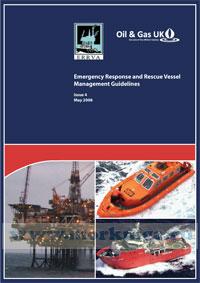Сб с 10 до 16
Emergency Response and Rescue Vessel Management Guidelines. Issue 4. May 2008
REFERENCES
Emergency Response & Rescue Vessel Survey Guidelines. Oil & Gas UK Guidelines for the Management of Emergency Response, Oil & Gas UK.
The Offshore Emergency Handbook, HSE.
OPITO Approved Emergency Response Standards for Standby vessel Crew
The Offshore Installations (Prevention of Fire and Explosion, and Emergency Response) Regulations 1995 (SI 1995 No. 743).
The Offshore Installations and Pipeline Works (Management and Administration) Regulations 1995 and Guidance.
SOLAS CH V Ord. Reg. 4 of MS (Safety of Navigation) Regulations 2002 SI 1473 Code of Safe Working Practices for Merchant Seamen International Convention on Standards of Training, Certification and Watchkeeping for Seafarers, IMO
HSE Offshore Technology Report, OTO95-038, Review of Probable Survival Times for Immersion in the North Sea, January 1996
CONTENTS
References Acronyms Definitions and Explanations of Terms Introduction
1 General Guidance
1.1 Fundamental Duties of an ERRV
1.2 Legal Requirements - PFEER
1.3 Other Guidelines and Standards relating to ERRV’s
1.4 Responsibilities of OIM and ERRV Master
1.5 Planning and Co-operation
1.6 Installation Emergency - Contingency Planning
1.7 ERRV Manning
1.8 Crew Fitness
1.9 Periods of Duty
1.10 Training
1.11 English Language Fluency
2 Routine Operations - Mobilisation to Location
2.1 Pre-Sailing and On-Passage Checks
2.2 Pre-arrival Documentation Check
2.3 Information to be Exchanged by Installation and ERRVs
2.4 Entry to Safety Zone
3 Routine Operations - On Location
3.1 Positioning
3.2 Errant Vessel Collision Risks to Installations
3.3 Manoeuvring within the Safety Zone
3.4 Fishing
3.4.1 Fishing Vessel Activity
3.4.2 Fouled Nets
3.4.3 Fishing from ERRVs
3.5 Loss of Equipment to Seabed
3.6 Close Standby
3.6.1 Definition
3.6.2 Communications with over side Work Parties during Close Standby
3.6.3 Radar Watch during Close Standby
3.7 Helicopter Operations
3.7.1 Notification of Helicopter Operations
3.7.2 Positioning during Helicopter Operations
3.7.3 Cover by ERRV and Daughter Craft
3.8 Personal Locator Beacons (PLB)
3.9 Surveillance
3.9.1 Watch keeping
3.9.2 Security
3.9.3 Buoyed Moorings Check
3.9.4 Installation Navigation Aids/Marks
3.10 Rescue and Recovery Equipment
3.10.1 Checks of Equipment
3.10.2 FRC Deployment
3.10.3 FRC Crew Pre-Launch Briefing
3.10.4 FRC Handling
3.10.5 Proximity to Installations
3.10.6 FRC Radio Communications
3.11 Daughter Craft (DC)
3.11.1 Daughter Craft Functions
3.11.2 Daughter Craft Operating Limits
3.11.3 Daughter Craft Crew Working Hours
3.11.4 Daughter Craft Response Times
3.12 Transfer Operations
3.12.1 Personnel Transfer between Installation and ERRV
3.12.2 Ship to Ship Transfer of Personnel by FRC
3.13 Weather Affecting Standby Cover
3.13.1 Exceptional Weather
3.13.2 Adverse Weather Working Policy
3.14 Communications
3.14.1 Communications Status
3.14.2 Change of Status
3.14.3 Notification to ERRV of Installation Operations
3.15 ERRV Records
3.16 ERRV Sharing Methodology
4 Routine Operations - Departure from Location Procedures
4.1 Handover to Relieving ERRV
5 Validation and Verification of Rescue and Recovery Arrangements
5.1 Assessment Methodology
5.2 Validation Trials
5.3 Verification
5.4 On-going, On-board Training
5.5 Drills and Exercises
5.6 Communications during Exercises
5.7 Record Keeping
6 Emergency Response
6.1 Primary Scenarios
6.1.1 Person(s) Falling from the Installation
6.1.2 Helicopter Ditching in the Vicinity of the Installation
6.1.3 Escape of Installation Personnel to the Sea
6.1.4 Recovery of Persons following Evacuation by TEMPSC
6.2 Emergency Situations
6.3 Emergency Response Actions
6.3.1 Command and Control Handover Procedures
6.3.2 Positioning of ERRV under Emergency Conditions
6.3.3 Search and Location
6.3.4 Radio Discipline/Communications
6.4 Survivor Management and Transfer
6.5 Emergencies Occurring Out with Assigned Area of Operation
6.6 Helicopter Winching Operations
6.6.1 The Decision to Winch
6.6.2 Radio Communications during Winching Operations
6.6.3 Permitted Air Band Radio Frequencies
6.6.4 Winching Operations Procedures
7 Environmental Emergencies
7.1 Oil Spills
7.2 Reporting of Spills
7.3 Circumstances in which Oil Dispersant may be used
7.4 Approval for and Guidance on the Use of Dispersant
7.5 Spraying Techniques
7.5.1 Circular Slicks
7.5.2 Long Slicks
7.5.3 Blow-out
7.6 Oil Spill Training and Exercises
7.7 Oil Spill Sampling
7.8 Secretary of State's Representative (SOSREP)
Appendix A: Data Cards
Appendix B: ERRV Emergency Response Plan for Offfshore Emergency and/or Evacuation or Escape
Appendix C: Example of Collision Avoidance Strategy
Appendix D: Typical Installation Navaids Checklist
Appendix E: Ship to Ship Transfer of Personnel By Rescue Craft Master’s Checklist
Appendix F: Adverse Weather Standards for ERRV, Flying Operations and Overside Working
Appendix G: Baseline Standards for Rescue and Recovery
Appendix H: ERRV Baseline Performance Validation Trial Procedures
Appendix I: Sample Emergency Scenario Checklist
Appendix J: Helicopter Winching Procedures
Appendix K: Infringement of Safety Zone Forms
Appendix L: Place of Safety
Appendix M:Recovery and Rescue Support ERRV Sharing Methodology
Appendix N: Use of Non-Certificated Emergency Response and Rescue Vessels

 Морские катастрофы
Морские катастрофы